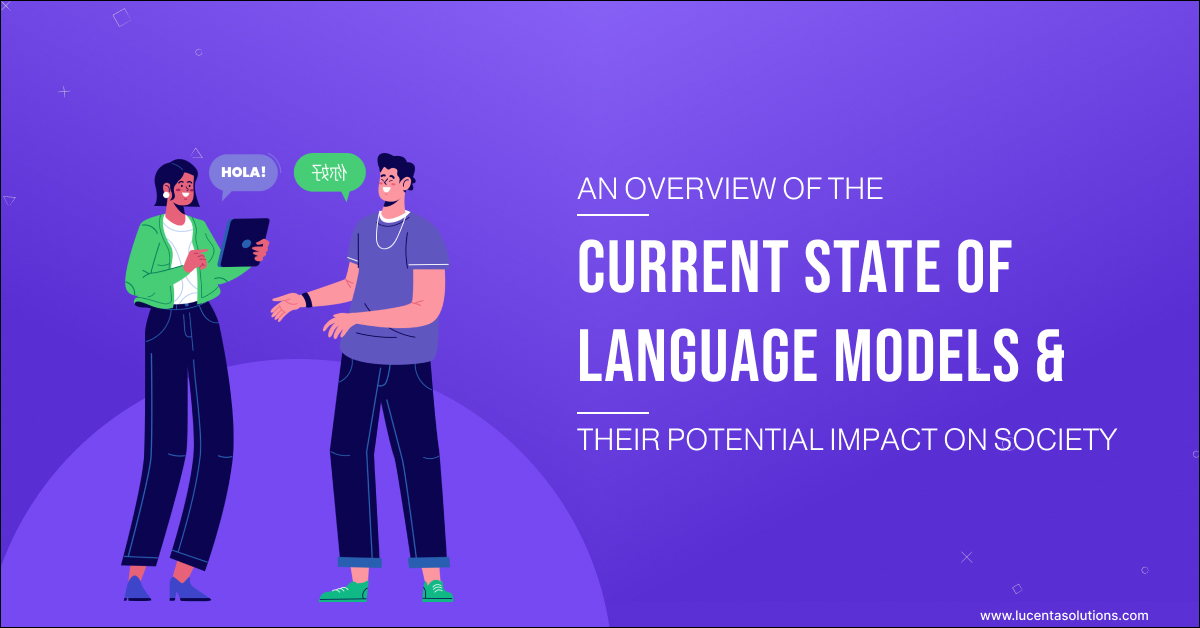An Overview of the Current State of Language Models and Their Potential Impact On Society
In November 2022, OpenAI unveiled ChatGPT, an AI-powered chatbot based on the GPT-3 language model. This powerful language model can replicate the intelligence of humans. The system hears user queries and understands the context of their request, allowing it to give appropriate replies to users as humans would.
In this blog, you will learn more about models, their current state, and their potential impact on society.
So, let’s get started.
What is a Language Model
A language model is a tool that quantifies the probabilities and statistics of a given sequence of words occurring in a sentence. To put it simply, it predicts the next word in a sentence with the help of machine learning technology.
Language models are helpful in many areas, such as: generating original texts, predicting the next word in a text, recognizing speech, and recognizing handwriting.
Language models don’t just consider grammatical validity when producing content; they consider a variety of factors to produce human-like content.
The term “large language model” refers to a language model trained on enormous data using techniques like supervised fine-tuning, in-context learning, few-shot learning, and so on.
Why Do We Need Language Models?
Natural Language Processing relies on language models to give machines access to the qualitative information contained in a text. These models convert qualitative information into quantitative data that machines can access.
A wide range of fields can be improved by using highly accurate language models, including logistics, healthcare, education, and many others.
By enabling machines to understand and generate human language, these models can improve improving how machines learn and respond accurately to user queries.
What are the Different Types of Language Models?
Language models in NLP fall into two main categories:
Statistical Models
Statistical models are applicable when you want the next word in a sequence to be predicted from the previous one. Furthermore, businesses can use multiple statistical language models to analyze their data. Numerous statistical models have already been used. Let’s have a look at some of the most popular ones:
N-gram
An N-gram language model refers to a document with a continuous sequence of symbols, words, or tokens. An N-gram language model might have features like identifying spelling errors, correcting them, preserving queries, retrieving information from inverted files and signatures, and identifying languages. The N-gram model estimates probabilities based on the frequency of specific word sequences in corpus texts.
Unigram
A Unigram is the most basic type of statistical language model. This model indicates that the probability of each word is independent of the likelihood of any words preceding it. Instead, it is only determined by how often it appears among all the words in the training text. Unigrams form the basis of more specific variants of the query likelihood model, which matches a specific query with the most relevant document in a pool of documents.
Bidirectional
The Bidirectional language model involves making a neural network that can process sequence information backward in both directions backward and forwards. In this model, the results are meant to be more accurate. There are a variety of possible applications of the bidirectional statistical model, which include applications such as machine learning and speech generation.
Exponential
The Exponential language models analyze text using n-grams and feature functions to determine what the text means. The model is based on the principle of entropy. Exponential models have fewer statistical assumptions, so their chances of producing accurate results are higher.
Continuous Space
The Continuous Space language model employs a neural network to arrange nonlinear weights to form words. Due to word embedding, weights are assigned to words, so any unknown values cannot mislead the model.
Neural Language Models
A neural network language model is built upon Neural Networks, which many experts consider a more advanced approach to Natural Language Processing. It is used for complex tasks such as speech recognition or machine translation and overcomes the shortcomings of statistical models such as n-gram.
What is the Large Language Model?
Large Language Models are a kind of artificial intelligence programs that comprehends, summarises, creates, and predicts new text using deep learning methods. The phrase “generative AI” is also strongly associated with language learning modules (LLMs), which are a subset of generative AI designed exclusively to assist in producing textual material.
Neural networks, often known as language models, are computer systems that draw inspiration from the structure of the human brain. These neural networks function using a layered network of nodes akin to neurons.
Besides instructing AI tools using human languages, large language models can be trained to execute an array of functions such as deciphering protein structures, composing software code, chatbot conversation, etc. Furthermore, they can understand and identify entities and their relationship with the textual data, ensuring an error-free outcome. It can work as an AI language model to capture complex language patterns written by humans.
Current State of Language Models
Large language models result from a vast amount of text data, increasing computing power, and advancements in AI research.
Having large datasets available has made it possible to train large language models, giving them access to a wide range of information that can be used to improve their performance.
The development of computational power at a lower cost has been a crucial factor behind the growth of natural language models. Today’s language models are based on transformers, an NLP architecture capable of handling sequence-to-sequence tasks and addressing long-range relationships. A combination of encoders and decoders generates the output in this system.
The development of large language models has resulted in the widespread use of these models across various industries and applications. Thanks to computers’ increased power and speed, large language models can now be analyzed on large datasets with high accuracy and complexity. The growth of AI research has also led to improvements in large language models’ performance due to new training techniques and algorithms.
What is the Potential Impact of Language Models on Society?
Language models have become more accurate and sophisticated, but further development and improvement are still needed. With the introduction of language models, one of the more significant issues was the evolution of ethical concerns. An effective language model is based on the analysis of vast amounts of data obtained from text, which may contain partial or misleading data. The perpetuation of biases in models may result in negative consequences for individuals or groups.
The fluency of these models can also produce false information, as people may believe humans made them. Models have been able to write convincing fake news articles written by humans.
An accurate language model can also generate texts that sound so realistic that they cannot be distinguished from texts written by humans.
What is the Future of Language Models?
Being an advanced AI language model, the future of LLM is transformative. There will be good development across different domains, making it worth investing in. With further development, they will become ever more adept at comprehending and producing writing that is human-like, disrupting fields like education, healthcare, and content production. The future of the language model involves-
Personalized Content Generation: In the future, LLM will be able to figure out user behaviour, marketing objectives, and more. It will help in personalized content generation, including news articles and marketing content.
Conversational Features: In the coming future, LLM will probably be crucial in creating conversational agents that are intelligent and have proper content awareness. This will allow for the enhancement of human-computer interactions and give users a personalized experience with a real-time focus on query resolution.
Particular Domain Solutions: LLM can address issues for a range of industries, including legal, financial, healthcare, and more. Professionals will find it easier to compile reports, assess informative data, etc.
Final Take
Language models are among the most promising areas of artificial intelligence in the future. This technology will affect many industries, including healthcare, automobiles, education, and application development.





